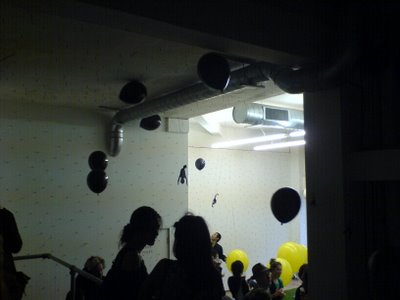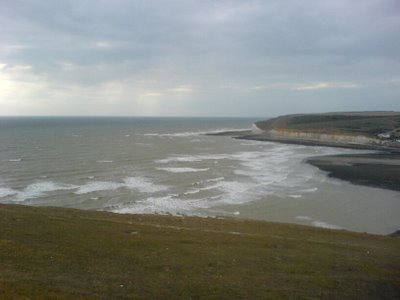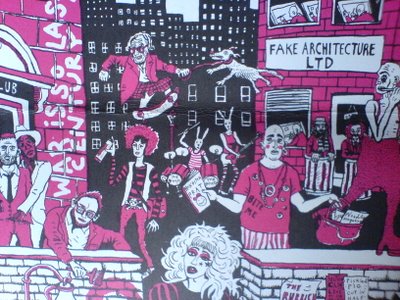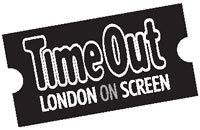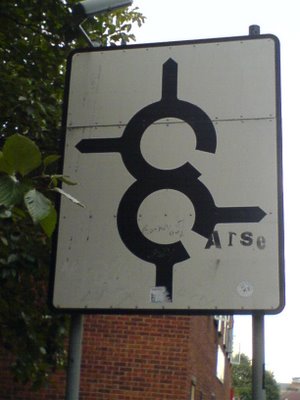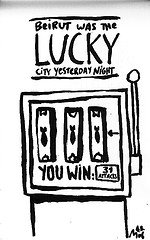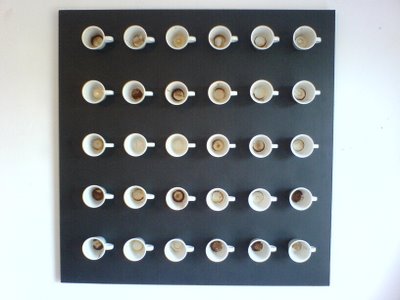Spillage Folk
The Cecil Sharp House near Regents Park houses The English Folk & Dance Society, I was aware of it’s existence from friends who attend ceilidhs that are hosted in the building but not being much of a dancer I have resisted the Society’s activities, until today that is. A couple of weeks ago I picked up a slightly grungy, photocopied flyer which advertised the ‘Blank Tape Spillage Fete'. With only one day left until the fete closes I decide to catch up with the event.
A handful of artists and musicians have been invited to create a ‘spillage’ tape, a kind of compilation, demo or collection of their music or sound recordings which they have been asked to fit onto two twenty minute sides of an audio tape. Along with the audio they were also asked to provide the artwork to accompany the tape.
Upon descending the stairs and entering the hall I was faced with the familiar village hall style fete scene, bunting is placed around the hall and at the head of the room is a stall selling various items. Around the walls are trestle tables with chairs and on the wall above the tables are black and white photocopies of a variety of images, text and drawings. On the tables lined with paper sit the tape cases, inlays, sketchbooks, paintings, drawings and sculptures of the artists and amongst these objects sit a variety of tape players, walkman’s and headphones. To complete the impression of the village fete is the nice touch of sitting the tape machines on white paper doilies.
To engage with all the exhibits is an epic feat but never has so much time in the context of an exhibition passed with such ease and enjoyment. The musicians have either given the context of the site very serious thought or the curators have done an exceptional job with their selection. The folk theme carries through the music but this is the point where the music is developing, traditional folk, pop and electronica all meld together. The musicians differing styles complement each other to the overall success of the project. The traditional folk sound is evident in My Dark Aunt’s contribution, simple but effective music is played with subtlety and this carries through in their finely crafted inlay and postcard. Phil Gardner never managed to produce any artwork but his song that listed all the places he’d visited in his life raised a smile in all those that heard it. Marcus Oakley recorded his jamming at home, he plays guitar while his brother plays along on an old fashioned children’s casio keyboard, the artwork to accompany included some slightly disturbing 60’s style cartoon images.
Throwing Shapes Away play Four Tet styled electronica and their sculpture of a deconstructed tape player spews out tape that has wrapped itself around a harmonica.
Luke Abbot’s 'DIY until I die' caught my ear as the first sounds I heard were reminiscent of a machine gaining conscious thought and beginning its attempts to sing in a fifties croon, this gives way to the slightly more conventional music which sounds like The Broadway Project as produced by AIR. Russell Wickwar plays a kind of East Anglian blues, his artwork a cardboard sculpture of a guitar with a guitar case that looks suspiciously like a coffin. Frank Hirota and End Of June play their lo-fi American sound allied with the mini AMERICAN LO-FI skateboard.
MMC started out like a street field recording which then moves into a filmic orchestral passage with elements of ambient feedback bubbling away in the mix.
The music of Woodworms featuring Giffle didn’t grab my attention but I was perhaps distracted by their psychedelic town plan, it looked like Buckminster Fuller had been given free reign to build a town in the future with the landscape to build on being comprised of oversize kittens. Kyran Lynn’s “Prisoners Of The Sun” provides no music at all but as a listening experience grabs you and takes hold, six people were asked to listen to a ham radio exchange previously recorded by Lynn and then repeat the words of the recorded speakers. From these repeated words he then overlayed the voices of the six new speakers, the balance of speech patterns and timings of the voices keeps you listening to the manner of their speech, only after some time do you begin to follow the conversation and then the disturbing nature of some of the political ideas being spoken become clear.
Of all the great recordings in this exhibition the one that caught my ear most was Half Cousin (Kev), on the wall above the tape player is a letter by Kev to the curators apologising for the quality of the recording. He explains the process that enables his music into being on the tape. His grungy, scratchy electronic folk production arrives at our ears via his 4 track machine “bouncing tracks on top of each other”, the final 4 track version is transferred onto mini-disc and from there onto the tape using his girlfriend's dad's stereo. He is obviously conscious of the distressed sound quality and his artwork echoes this with his distressed dirt encrusted tape case and inlay, next to that sits an old equally muddy and dirty copy of the book ‘Don Quixote’, the book is open at the inside cover and with all the pages removed you can see two images, the left hand image of scenes from the book and the right hand side a portrait hand drawn in biro.
This is in keeping with the feel of the show, the recordings are necessarily lo-fi, the artwork is finely crafted but often produced from modest materials and is housed in the village hall atmosphere of the equally down to earth and modest environs of The Cecil Sharp House.
There are tentative rumblings that the Blank Tape Spillage Fete hopes to return next year. I hope so, it should become a permanent fixture on our village calender.




